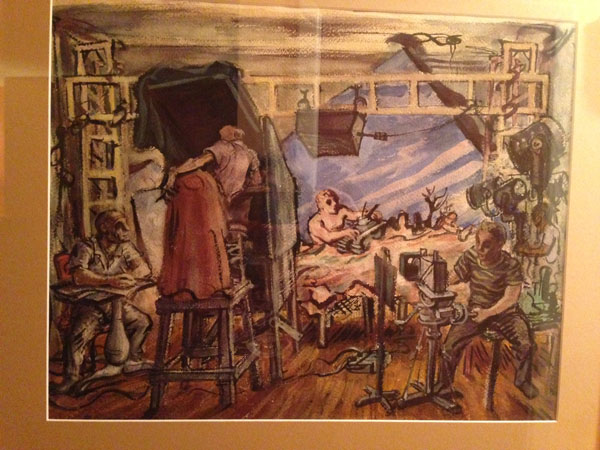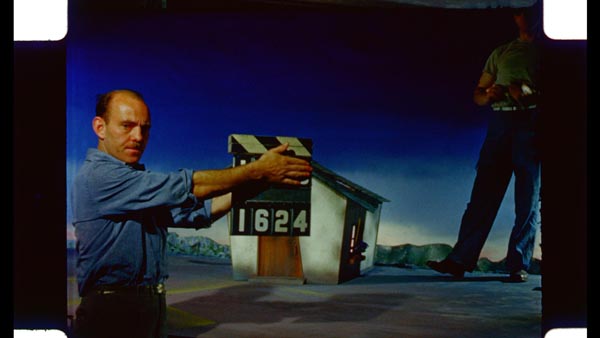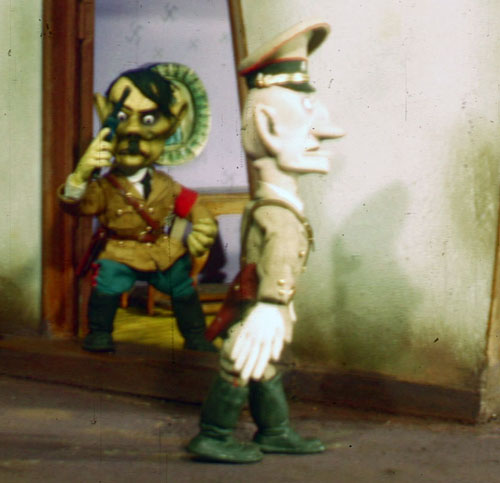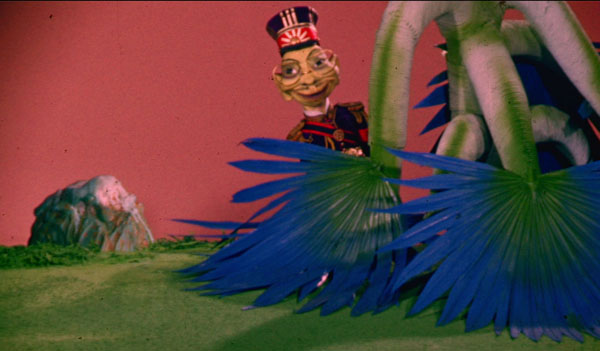This week, a little look behind the scenes of Lou Bunin’s Bury the Axis (1943) – courtesy of Kodachrome!
Lou Bunin was a wonderful stop motion animator. Lou had a long and distinguished career as an Mural artist, animator, puppeteer, Educational Film producer, and in later years, a college professor at the School of Visual Arts. He is best known for his feature film, Alice in Wonderland (1949) and for the animation at the opening of the film Ziegfeld Follies (1946). Bunin also created many short films over the years, including the puppet animation in the famous ‘Brylceem’ commercials:
We’re working with Lou’s daughter, Amy Bunin Kaiman, on a set of Lou’s productions and thought this week we’d give a short sneak peek at a few cool things. The set has been in progress for a while, but I do hope to get it finished this year and available. It will feature Alice as well as many of Lou’s shorts and commercials.
Amy started a Lou Bunin blog a while back featuring Lou’s work.
Amy was kind enough to have sent along some of the film materials from Lou’s career. I was thrilled to transfer the films contained in the box, ranging from complete productions to a clip from the Perry Como show featuring Bunin’s animation, to a can labeled ‘Bury the Axis outtakes’. Inside were many small rolls of Kodachrome footage, dating from 1943. They are all outtakes and camera tests from Lou’s 1943 production, Bury the Axis. The film was released in Cinecolor, but these outtakes were in full color on Kodachrome stock. Perhaps Lou was shooting it both ways in case the Cinecolor version wasn’t released. There’s a good 10 minutes of these outtakes. We’ve transferred them and they’ll appear on the set. For now, here’s some great stills from the footage.
Amy sent along this snapshot of a painting by artist Phil Reisman, done while Lou was animating the short. It looks from this painting that perhaps there were two cameras filming. I wonder if the whole film was produced in Kodachrome as well. It was released in 35mm Cinecolor. I wonder if another print of the film will show up at some point.

Here’s a scene from early on in the picture. It may not have been used at all, or it could be that it’s just missing from the print that is available. It features Bunin’s puppet flying out of a manhole cover. The outtakes have this scene done over and over, with varying results.

Here’s a shot of Lou in back of his set of Hitler’s house. This gives you a pretty good idea of the scale of the puppets and sets.

Here’s a few more shots featuring a yet unidentified helper on the set (our guess is that he’s the photographer). That may very well be him on the far left in the painting.



There are various animated sequences in the outtakes that never made it into the finished film, including a sequence with Hitler wilting flowers by being near them, and killing an Military (SS?) guard:


One of the coolest thing about the footage is seeing what these scenes looked like in full color. This shot has a really cool color palette, and was done as a matte shot (with half the picture blocked with a matte box in front of the lens)


You get some idea of what this film would have looked like in full color. The purple of the hat is especially striking:

Here’s the completed film. We hope to find a 35mm source on it and do a new HD transfer if we manage to be so lucky:
Have a great week everyone!


 Steve Stanchfield is an animator, educator and film archivist. He runs Thunderbean Animation, an animation studio in Ann Arbor, Michigan and has compiled over a dozen archival animation DVD collections devoted to such subjects at Private Snafu, The Little King and the infamous Cubby Bear. Steve is also a professor at the College for Creative Studies in Detroit.
Steve Stanchfield is an animator, educator and film archivist. He runs Thunderbean Animation, an animation studio in Ann Arbor, Michigan and has compiled over a dozen archival animation DVD collections devoted to such subjects at Private Snafu, The Little King and the infamous Cubby Bear. Steve is also a professor at the College for Creative Studies in Detroit.






















Without seeing the full sequence, I can’t comment fully on the shooting-of-the-guard, but it is highly unlikely that it’s an SS guard. The SS wore black uniforms that were quite distinctive. It’s possible that it might be an allusion to the “Knight of the Long Knives” in 1934, when Hitler caused a bloody purge to be carried out against the SA, which wore distinctive brown uniforms (though significantly different hats from that shown in the still). The Germany Army is possible, though they wore field-grey uniforms, and the major purges against the Army wouldn’t come until the aftermath of the failed July, 1944 assassination attempt.
Watching the film, I was reminded in a few spots of Norm McCabe’s contemporary “The Ducktators,” which covers much the same ground.
Wow, I can’t wait for this Lou Bunin retrospective! I can’t recall whether I’ve seen his version of “ALICE IN WONDERLAND”, but the short films and commercials will be a lot of fun! Great posts as always, Steve!
Here you go. https://www.youtube.com/watch?v=RbAv1r4UqDM
Could “Bury the Axis” have been shot on Kodachrome, but with release prints in Cinecolor? Material did get released in Cinecolor that wasn’t necessarily shot using the Cinecolor process.
It’s hard to say right now… Lou did keep documentation of many things, so it’s possible that we’ll know how it was done. Looking at the painting, it looks like the woman looking through the draped area might be looking through a 35mm camera setup, and that the 16mm is the secondary system. If it was shot in 2 color at the same time, it was shot progressively in black and white with a color wheel in front of the camera. It would make sense that it was all shot 16mm from finding this material, but time will hopefully tell!!!
I’ve been looking forward to “Alice in Wonderland” since you first mentioned it and now with the addition of the shorts and commercials, I just can’t wait! Thank you and Keep up the great work!
I had Lou as a teacher back at SVA, he was really a nice man. He showed the class arerl of his commercials and full clip from Ziegfeld Follies. He taught us his technique for making puppets. He sculptured the heads in wax to get that smooth shiney texture when cast in a thin coat of latex rubber . The heads were fitted with a bolt at the bottom so they could be easily reaplaced on the body. He would replace the heads for extreme expression changes not for mouth movements like puppet toons. His puppets had wires in the lips for basic mouth movements. For the armatures he always used woven wires…not ball and socket joints. I love his design sense with his puppets. I read an article that showed some amazing puppets from some aborted projects like Wagner’s opera THE RING OF THE NIBELUNG, and DON QUIXOTE. He was a tremedous artist, I was lucky to have known him.
Hello! Who holds the rights to BURY THE AXIS? Is it P.D.?
I thot your STOP-MOTION MARVELS was a treasure and have been mentioning it to people for quite awhile. You can be sure I’ll snap this one up. Bunin is not very well-known and I am always going to support the pioneers. Charley Bowers immediately comes to mind for his astonishing shorts. I noticed that several of the Bunin ALICE IN WONDERLAND puppets were being sold, possibly recently. Best of luck – and keep up the outstanding work!